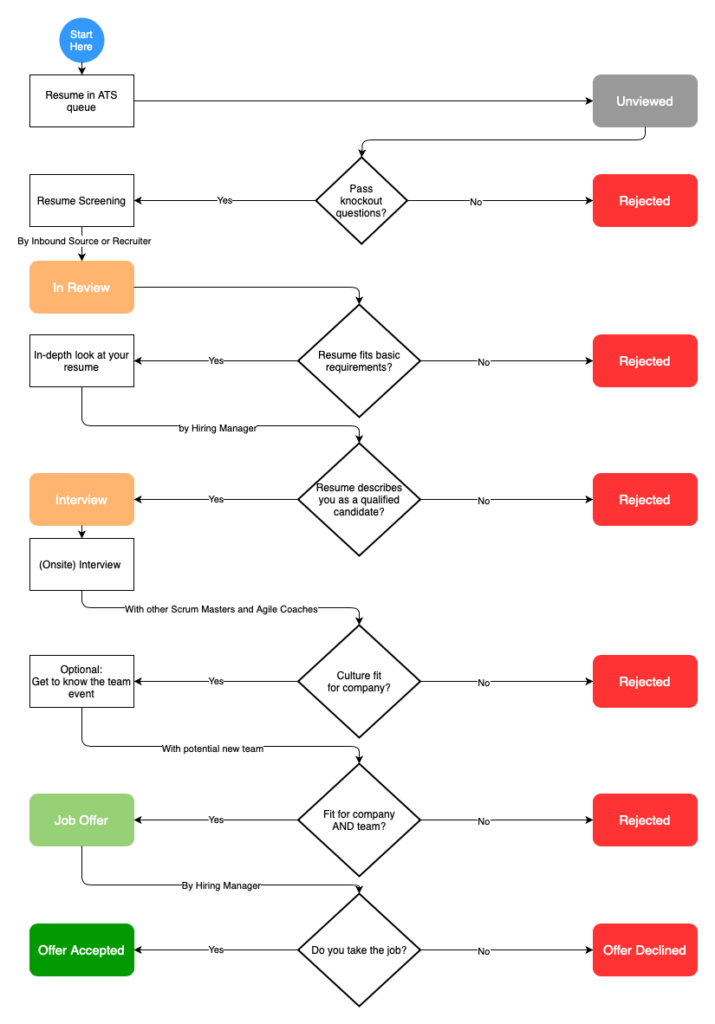You don’t learn how to apply for a new position. Nobody does. You do not learn it in school or university. Even your parents or friends can not help you get your dream job.
After you hit the “Apply” button on a job posting, everything that happens seems to be a black hole.
The missing knowledge about how recruiters work, what tools they use, and who decides about getting rejected or to the next stage of the hiring process leads to myths and misunderstandings.
Resume writing services use those myths to sell their services without getting you a step closer to your dream job. They advertise their expertise in keyword optimization and claim they can beat an Applicant Tracking System for a few hundred dollars.
Their business is based on your insecurity and desire to land your Scrum Master job. In a past article, I explained why they do not have in-depth knowledge about the Scrum Master role.
In this article, we will have a deep dive into how Applicant Tracking Systems work. We will bust common myths about ATS, and you will understand why you do not need to fear getting rejected by a machine.
What Is an ATS?
An Applicant Tracking System helps recruiters and HR departments manage the application process for every company’s position. They are built better to assist the management of resumes and applicant information.
Some ATS provide automatically parsing resumes to make it easier for recruiters to identify relevant information. As of 2021, none of the major ATS reject resumes automatically. The reason for this is dead simple:
Recruiters and companies fear missing a great candidate.
Recruiters know that you are not trained to write a great resume. And they do not expect you to be the best resume writer in the world. They expect you to be a great Scrum Master.
Basic ATS Workflow
While every company has its own recruiting process, the ATS workflow looks something like this:

Rectangles describe actions during the hiring process. Rectangles with rounded corners represent the current status in the ATS, starting with “Unviewed“. Depending on decisions presented in parallelograms, people (recruiting staff) move your Scrum Master resume to the next stage – not machines.
If you want to know about ATS in-depth, please have a look at Amy Miller’s video: The Truth About The ATS
Amy recruited at Microsoft, Google, and Amazon, and she shares her insights on her Youtube channel.
Busting ATS Myths
We will check out the top fallacy websites used by resume writing services and self-proclaimed career gurus claiming false facts about ATS.
1. You Are Rejected By a Machine
There is a persistent myth about ATS rejecting resumes automatically.
Claims like this are not valid.
Recruiters fear missing a great candidate.
They will almost always have a look at your resume.
There are two exceptions to this:
- The hiring funnel is already full of qualified candidates.
- You are not eligible for that position.
When a company already has a few hundred qualified candidates in their pipeline, they stop processing resumes.
In some cases, companies have constraints hiring certain people: For example, if they can not sponsor visas, recruiters may add additional questions to the job application form like
“Do you need sponsorship to work?”
People needing visas will get rejected.
Those questions are a kind of knockout question. They are not part of your resume screening; they are part of the job application form.
Using a resume writing service will never get you past those knockout questions.
That sounds harsh, but if the company has constraints, there is not much you can do. Have a look at another open Scrum Master position.
2. Your Resume Needs to be ATS-compatible
Most job application forms allow uploading common files like *.docx, *.doc, *.pdf and even *.jpg and *.png files. They try to make it as easy for you to get your resume uploaded, even when you use image files.
Applicant Tracking Systems do resume parsing. That is the process where the ATS attempts to auto-fill your details. ATS and recruiter do not use this information to filter anything during the resume screening.
There is nothing like an ATS-compatible resume.
Claiming to create an ATS-compatible resume is like a mobile-compatible website. Every website is mobile compatible. Your resume is also ATS-compatible by default—no need to waste money on buzzword marketing.
Suggestion: Go with PDF or Word documents, and you are fine. ATS can parse PDF files and Word documents well enough.
3. ATS Resume Optimization Services
There is a whole industry selling products and services to optimize your resume to bypass the ATS algorithm, so the recruiter will directly look at your application. Those providers charge for a few hundred dollars.
The truth: There is no bypass.
Recruiters and HR departments have well-established workflows, and there is nothing you can do to bypass parts of their workflow. Once you applied, your resume is part of the hiring funnel waiting for the recruiter to review it.
Write a Resume Tailored to the Job
An ATS workflow is human-based. Humans decide to push your resume to the next stage or reject your application.
Let’s recap: The hiring manager defines the requirements for your Scrum Master position. The recruiter scans your resume and decides: Next stage or rejection.
The only thing you can do (and you can do this without paying hundreds of dollars) is to write a resume tailored to the job description. Your resume needs to help the recruiter during resume screening to recognize you are a qualified candidate. No magic here.
Learn How to Write a Compelling Scrum Master Resume That Gets You Interviews
Over the next few weeks, I will write articles that will help you write a compelling resume without paying hundreds of dollars for professional writing services or resume templates.
Sign up below to get early access to new articles, guides, updates, and more. 👇

